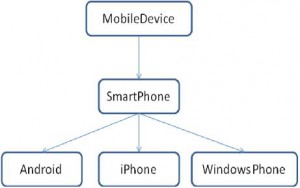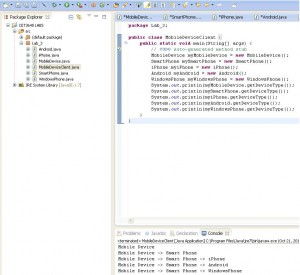Lab Description:
In this program we are going to use inheritance with the keyword extends to create six programs that will show the following hierarchy:

We will define the superclass and subclass and apply override method on the subclass.
Code:
package Lab_3;
class MobileDevice {
private String deviceType = "Mobile Device";
public String getDeviceType() {
return deviceType;
}
public void setDeviceType(String MobileDevice) {
this.deviceType = MobileDevice;
}
}
package Lab_3;
class SmartPhone extends MobileDevice {
private String deviceType = "Mobile Device -> Smart Phone";
@Override
public String getDeviceType() {
return deviceType;
}
public void setDeviceType(String deviceType) {
this.deviceType = deviceType;
}
}
package Lab_3;
class iPhone extends SmartPhone {
private String deviceType = "Mobile Device -> Smart Phone -> iPhone";
@Override
public String getDeviceType() {
return deviceType;
}
public void setDeviceType(String deviceType) {
this.deviceType = deviceType;
}
}
package Lab_3;
class Android extends SmartPhone {
private String deviceType = "Mobile Device -> Smart Phone -> Android";
@Override
public String getDeviceType() {
return deviceType;
}
public void setDeviceType(String deviceType) {
this.deviceType = deviceType;
}
}
package Lab_3;
class WindowsPhone extends SmartPhone {
private String deviceType = "Mobile Device -> Smart Phone -> WindowsPhone";
@Override
public String getDeviceType() {
return deviceType;
}
public void setDeviceType(String deviceType) {
this.deviceType = deviceType;
}
}
package Lab_3;
public class MobileDeviceClient {
public static void main(String[] args) {
// TODO Auto-generated method stub
MobileDevice myMobileDevice = new MobileDevice();
SmartPhone mySmartPhone = new SmartPhone();
iPhone myiPhone = new iPhone();
Android myAndroid = new Android();
WindowsPhone myWindowsPhone = new WindowsPhone();
System.out.println(myMobileDevice.getDeviceType());
System.out.println(mySmartPhone.getDeviceType());
System.out.println(myiPhone.getDeviceType());
System.out.println(myAndroid.getDeviceType());
System.out.println(myWindowsPhone.getDeviceType());
}
}




